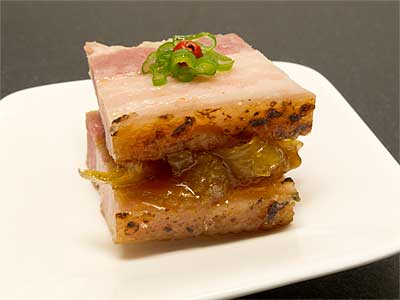September 26, 2011
Amuse-Bouche

« sandwich » au poitrine de porc
(pork belly “sandwich”)
I find the current pork belly craze both curious and bewildering. It’s curious because normally fat-adverse people are eating this fatty morsel in fancy restaurants like it’s something exotic and unusual. Bewildering because this portion of the pig that was in the past reserved for the poor is now on the plates of the rich. Even though now common in restaurants, the fancy butcher shops in my area still don’t sell pork belly along side their overpriced pork loins and rib chops. (Luckily, we appear to be on the backside of the growth curve, and pork belly may soon fade from the menu.)
I’ve been buying and cooking pork belly since the 1970s. In those days I had to buy it from a Chinese butcher, but that was okay with me since I was using it for Chinese recipes. In 1981, when my future wife ate my pork belly dishes, I won her over. When I started cooking French food in the 90s it was easy for me to find recipes that used pork belly in my French recipe sources. Pork belly, at least in the form of lardons, is ubiquitous in French cuisine. One of my favorite non-lardon recipes is for a braised slab of pork belly that shares the primary characteristic of my Chinese recipes. Namely, that the fat is transformed from a stiff, greasy block into a gelatinous mass that’s truly a pleasure to eat.
When it became possible to order pork belly from a white-linen restaurant, I noticed that most of them were cooking the meat sous vide and then searing the fat side before serving. So when I started cooking sous vide in my humble little kitchen, I had to give it a try. I was curious to see how cooking the same piece of meat for 1 to 2 days was superior to my usual 90-minute braise. So one day, when I was brining some slabs of pork belly in preparation for making bacon, I set one aside to cook sous vide. I brined the slab for 3 days in a 3% salt, 2% sugar brine as calculated using the Brine Calculator in the Tools Section of this website. I decided to add an appropriate amount of sodium nitrite to the brine to preserve the color and kill any botulism spores that might be present; after all, the meat was going to be cooking for a long period of time in an anaerobic condition, the type of environment that botulism likes.
I wound up cooking the slab of pork belly for about 18 hours. The result was that my wife and I both thought the recipe needed more work. Everything was just too soft that night. We ate about two-thirds of the slab, and I wrapped the reminder tightly in plastic wrap and set it aside for another use.
By the time the piece had chilled overnight, the texture had firmed up and ideas began to flow. Before cutting the piece, I seared the fat side with a butane torch to give it a little color. I figured that if I cut the leftovers into 8-mm (1⁄3-in) thick slices and then cut each slice into 25-mm (1-in) long strips, I could get about 10 pieces plus scraps. I ate the scraps and liked what I was tasting—sort of a pork belly ham. I vacuum packed the slices in a single layer and threw them into the freezer to serve at a later date.
I decided that each serving would be a sandwich of two slices with a filling in between. Here’s where having lots of miscellaneous ingredients at hand comes in handy. Between various chutneys, preserves, and sauces I decided to use a Meyer-lemon marmalade. The slices were reheated in the vacuum bag to about 55 °C (131 °F). On top of each “sandwich”, I placed a garnish of a small mound of finely cut green onions and a single pink peppercorn. (Yum.)
© 2011 Peter Hertzmann. All rights reserved.
